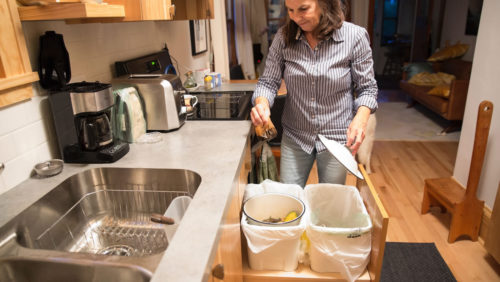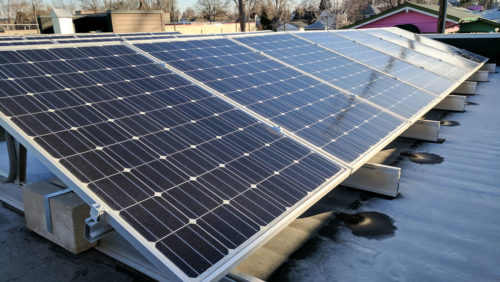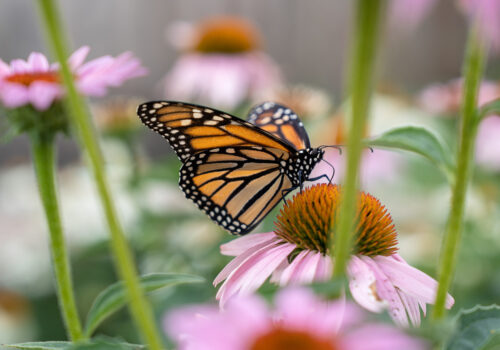Four Practical and Creative Ways to Become More Earth-Friendly
Earth Day, now in its 48th year, is a celebration of the planet we call home. Here at MWMO, we do everything we can to be environmentally friendly, even outside of our work protecting and improving water quality.
From changing our behaviors to making sure the products we use will sustain the environment in the long run, we strive to make our impact on the planet as small as possible. This year, as we celebrate Earth Day (Sunday, April 22) we wanted to share some of our staff’s very own tips and tricks for becoming more environmentally friendly.
Ditch the Toxic Cleaning Chemicals

Cleaning is a necessary chore for all of us; unfortunately, many of the cleaning products available in stores are needlessly harmful to the environment and/or potentially toxic to humans.
If you have ever been to our building or met us at an event, you have probably seen the eco-friendly cleaning recipe we use and recommend for preventing water pollution. It’s actually derived from the Minnesota Pollution Control Agency’s all-purpose cleaner recipe, which can be found in their non-toxic cleaning recipe list (PDF). Hennepin County offers a similar array of green cleaning recipes (PDF) to be used for a variety of specific purposes around the home. You might want to try out different recipes and see what works best for you.
If you’re not interested or able to make your own DIY cleaners, you can focus on purchasing store-bought cleaners that are non-toxic. This can be tricky, as product labels are not always truthful. Don’t trust a product just because its label says “non-toxic” or “all natural.” Look for a label like Green Seal, which indicates that the product has been through a certification process. Or, do some research on sites like the Environmental Working Group’s Guide to Healthy Cleaning, which rates products according to their relative environmental and health concerns. Doing a little research can help you avoid products that have been “greenwashed” — i.e., products that present themselves as environmentally friendly when in fact they are not.
Save Money by Going Green

Changing our everyday habits can have a big impact on the environment. But, we know that breaking old habits can also be hard. If saving the Earth isn’t motivation enough for you, consider that many of these things will also save you money.
Joining a local food co-op is an example of a simple choice that can yield both financial and health benefits while also supporting more sustainable forms of agriculture. Going car-free and choosing transit, biking or walking over driving can save you huge sums of money while also reducing air pollution and your carbon footprint. (Using handy tools like Metro Transit’s trip planner or Nice Ride might help simplify your car-free transition.) Shopping with reusable bags cuts down on the amount of plastic polluting the environment, and some stores will offer you a discount for doing it.
Lowering your thermostat and dressing for the weather is a no-brainer to help lower your heating bills, but there are other added benefits. Turning down the thermostat is actually good for some houseplants, and cooler temperatures cause your body to expend more energy to keep warm, thus burning more calories. (If you really can’t stand the cold, simply programming your thermostat to reduce the temperature when you’re not at home is another option.) Then there’s the age-old practice of turning off the lights off when you leave a room. It might seem like a cliché, but it takes almost no effort and reduces your energy consumption.
Other types of changes don’t save you money directly, but allow you to do good at no cost to yourself. For example, I recently changed my web browser’s default search engine to EcoSia. Every time I search for something, the ad revenue generated is used towards sustainability efforts such as planting trees. Going green doesn’t get much easier than that!
Know Your Waste Streams

The average American generates nearly 4.5 pounds of solid waste every day (more than 1,600 pounds per year) according to the U.S. Environmental Protection Agency (PDF). Knowing what you use and throw out on a daily basis is an important step in being more environmentally friendly.
Here at the MWMO, we use the City of Minneapolis’ curbside pick-up of trash, recycling, and organics. For other things like old computers, hazardous waste, and things that no longer work we utilize Hennepin County’s collection events and drop-off locations. Depending on where you live, your city may also offer similar programs to help get rid of these items.
There are numerous resources to help you understand waste streams. One that we have found very useful is Hennepin County’s green disposal guide. This is a great place to answer all your questions about what can be disposed of and where. As I mentioned, we utilize curbside pick-up of organics here at the MWMO, so Hennepin County’s Organics guide is a very useful tool for anyone looking to compost to ensure organic materials being thrown out are indeed organic. Finally, this helpful graphic is something I found that makes understanding all of those numbers on your plastic containers much easier. What is picked up by your city or local hauler varies by location, but we have found these resources to be a great starting point to better understand the waste streams and how to properly dispose of them.
Invest in Efficiency and Conservation

Up until this point, these tips have had to do with small changes that may cost little or next nothing. But those who can afford to invest in eco-friendly improvements to their home or business can reap large rewards.
A great place to start in determining where you can begin making changes is by getting a home or business energy audit. Doing an energy audit is an important step in determining where you are currently doing well and where there are areas for improvement. Armed with this knowledge, you can make targeted home energy upgrades. Organizations like Center for Energy and the Environment offer financing programs for both businesses and residents. Other programs might be offered selectively by where you live, like the Minneapolis Green Business/Housing Cost Share Program. Your energy auditor will know what programs may fit your needs and can offer advice on which opportunities would be best to utilize.
In a previous blog post, I discussed how the installation of our solar array and the systems that came with it have informed how we manage our building. Our eGauge system gave us the ability to see our electricity consumption habits compared to the production of the solar array. As a result, we took a much more hands-on approach to managing our building’s systems. This allowed us to reduce our average monthly electricity bills by $254.09. We project that our solar panel system will have paid for itself by early- to mid-2021.
Of course, this wouldn’t be an MWMO blog post if we didn’t talk about water! The website you’re on right now features a library of information on things like water-friendly yard care practices and landscaping ideas that can get you started on protecting local water quality and habitat. Many of these practices are low-cost, but funding might also be available through your city or county. The MWMO also offers a series of grants for projects that protect and improve water quality and habitat. These funds can be utilized by our member cities, partner organizations, neighborhood groups, and businesses.
What are your own personal tips for sustainability? Let us know in the comments how you’ve been able to green up your everyday habits.



